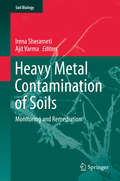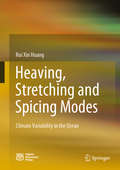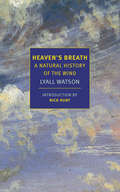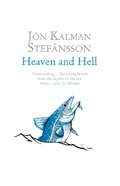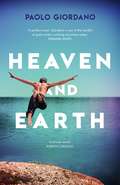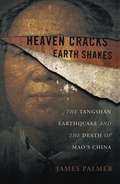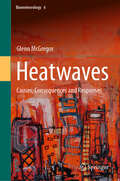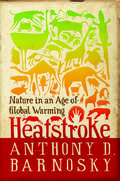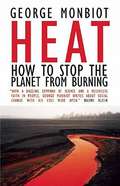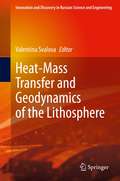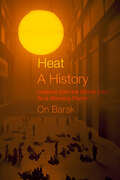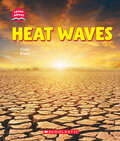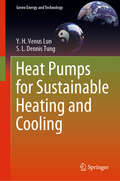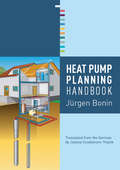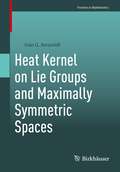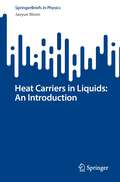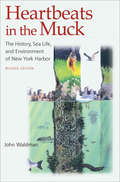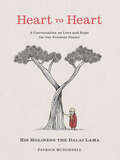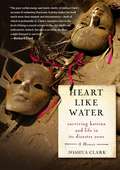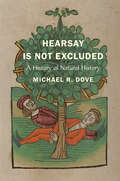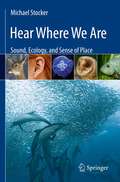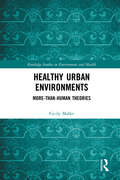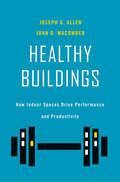- Table View
- List View
Heavy Metal Contamination of Soils
by Ajit Varma Irena SherametiFollowing a description of the various sources and factors influencing the contents of heavy metal pollution in post-catastrophic and agricultural soils, subsequent chapters examine soil enzymes and eggs as bio-monitors, lead adsorption, the effects of arsenic on microbial diversity, and the effects of Mediterranean grasslands on abandoned mines. A third section focuses on the adaptation strategies used by plants and bacteria, such as Pinus sylvestris in industrial areas, and the rhizosphere in contaminated tropical soils and soil treated with sewage sludge. Further topics addressed include strategies of bioremediation, e. g. using transgenic plants as tools for soil remediation. This new volume on heavy metals in soil will be of interest to researchers and scholars in microbial and plant biotechnology, agriculture, the environmental sciences and soil ecology.
Heaving, Stretching and Spicing Modes: Climate Variability in the Ocean (Springer Oceanography Ser.)
by Rui Xin HuangThis book is focused on fundamental aspects of climate variability in the ocean, in particular changes of the wind-driven circulation. The vertical movement of isopycnal (isothermal) layers, including their stretching and compression, is called heaving and stretching. A major part of climate variability in the ocean is heaving in nature. Heave is primarily associated with the adiabatic motions of isopycnal layers due to change of wind stress. It is rather difficult to separate the contributions from adiabatic and diabatic processes.Isopycnal analysis has been widely used in climate study; however, it is much more accurate to study the isopycnal layers. Here climate signals are examined in terms of changes of layer depth, layer thickness, layer temperature/salinity, spicity and others.In addition to the traditional Theta-S diagram, the sigma-pi (potential density – potential spicity) diagram can also be used in analyzing water mass property distribution and climate variability. In fact, a radius of signal can be defined rigorously for signals in the sigma-pi diagram; the combination of isopycnal analysis and evaluation of radius of signal provides a powerful tool in analyzing climate variability in the world oceans.
Heaven's Breath: A Natural History of the Wind
by Lyall WatsonWind is everywhere and nowhere. Wind is the circulatory system of the earth, and its nervous system, too. Energy and information flow through it. It brings warmth and water, enriches and strips away the soil, aerates the globe. Wind shapes the lives of animals, humans among them. Trade follows the path of the wind, as empire also does. Wind made the difference in wars between the Greeks and Persians, the Mongols and the Japanese. Wind helped to destroy the Spanish Armada. And wind is no less determining of our inner lives: the föhn, mistral, sirocco, Santa Ana, and other “ill winds” of the world are correlated with disease, suicide, and even murder.Heaven’s Breath is an encyclopedic and enchanting book that opens dazzling new perspectives on history, nature, and humanity.
Heaven and Hell
by Jón Kalman StefánssonIn a remote part of Iceland, a boy and his friend Barður join a boat to fish for cod. A winter storm surprises them out at sea and Barður, who has forgotten his waterproof as he was too absorbed in 'Paradise Lost', succumbs to the ferocious cold and dies. Appalled by the death and by the fishermen's callous ability to set about gutting the fatal catch, the boy leaves the village, intending to return the book to its owner. The extreme hardship and danger of the journey is of little consequence to him - he has already resolved to join his friend in death. But once in the town he immerses himself in the stories and lives of its inhabitants, and decides that he cannot be with his friend just yet. Set at the turn of the twentieth century, Heaven and Hell is a perfectly formed, vivid and timeless story, lyrical in style, and as intense a reading experience as the forces of the Icelandic landscape themselves. An outstandingly moving novel.
Heaven and Hell
by Jón Kalman StefánssonIn a remote part of Iceland, a boy and his friend Barður join a boat to fish for cod. A winter storm surprises them out at sea and Barður, who has forgotten his waterproof as he was too absorbed in 'Paradise Lost', succumbs to the ferocious cold and dies. Appalled by the death and by the fishermen's callous ability to set about gutting the fatal catch, the boy leaves the village, intending to return the book to its owner. The extreme hardship and danger of the journey is of little consequence to him - he has already resolved to join his friend in death. But once in the town he immerses himself in the stories and lives of its inhabitants, and decides that he cannot be with his friend just yet. Set at the turn of the twentieth century, Heaven and Hell is a perfectly formed, vivid and timeless story, lyrical in style, and as intense a reading experience as the forces of the Icelandic landscape themselves. An outstandingly moving novel.
Heaven and Earth
by Paolo Giordano'A devastating marvel of a novel' Sunday Telegraph 'A highly enjoyable novel... Giordano is especially good on the textures, smells, heat and colours of the Italian south. These stay long in the mind, as does the way he writes about the obsessiveness of love, the way it dominates and distorts and the self-delusions and fantasies it gives rise to' TLS 'If you're pining for an Italian break, then this might be the remedy: Heaven And Earth is rooted so deep in idyllic Puglia that you can almost feel the red soil under your sandals' Daily Mail 'Raw and evocative: a breathtaking and poignant creation that will leave you itching under the skin' Herald 'A stunning achievement' André Aciman, author of Call Me By Your Name 'Perfect, moving, honest, brilliant, with characters who feel like old friends' Andrew Sean Greer, Pulitzer Prize-winning author of Less 'The perfect novel. Paolo Giordano is one of the handful of great writers working anywhere today' Edmund White Every summer Teresa follows her father to his childhood home in Puglia, down in the heel of Italy, a land of relentless, shimmering heat, centuries-old olive groves and taciturn, proud people. There Teresa spends long afternoons enveloped in a sun-struck stupor, reading her grandmother's cheap crime paperbacks.Everything changes the summer she meets the three boys who live on the masseria next door: Nicola, Tommaso and Bern - the man Teresa will love for the rest of her life. Raised like brothers on a farm that feels to Teresa almost suspended in time, the three boys share a complex, intimate and seemingly unassailable bond. But no bond is unbreakable and no summer truly endless, as Teresa soon discovers. Because there is resentment underneath the surface of that strange brotherhood, a twisted kind of love that protects a dark secret. And when Bern - the enigmatic, restless gravitational centre of the group - commits a brutal act of revenge, not even a final pilgrimage to the edge of the world will be enough to bring back those perfect, golden hours in the shadow of the olive trees.PRAISE FOR PAOLO GIORDANO 'Mesmerizing... Giordano works with piercing subtlety' New York Times'Elegant and fiercely intelligent' Elle'Elegiac, tender and mournful' Wall Street Journal
Heaven Cracks, Earth Shakes: The Tangshan Earthquake and the Death of Mao's China
by James PalmerWhen an earthquake of historic magnitude leveled the industrial city of Tangshan in the summer of 1976, killing more than a half-million people, China was already gripped by widespread social unrest. As Mao lay on his deathbed, the public mourned the death of popular premier Zhou Enlai. Anger toward the powerful Communist Party officials in the Gang of Four, which had tried to suppress grieving for Zhou, was already potent; when the government failed to respond swiftly to the Tangshan disaster, popular resistance to the Cultural Revolution reached a boiling point. In Heaven Cracks, Earth Shakes, acclaimed historian James Palmer tells the startling story of the most tumultuous year in modern Chinese history, when Mao perished, a city crumbled, and a new China was born.
Heatwaves: Causes, Consequences and Responses (Biometeorology #6)
by Glenn McGregorDistinctively, this book brings together an end-to-end understanding of heatwaves, that is, a consideration of their causes, consequences for human and natural systems and societal responses to them in the form of adaptation and mitigation actions. It advocates for recognizing "the heatwave imperative" and emphasizes that “heatwaves matter”. Together, the individual chapters make the point that “knowing heatwaves” from a holistic interdisciplinary perspective will assist with efforts towards heatwave risk reduction and building resilience to what is probably the most pervasive of a range of climate hazards. The book will be of interest to upper level undergraduate and taught postgraduate students and researchers in geography, climatology, environmental, atmospheric and population health sciences as well as climate and health researchers, urban planners, policy makers and the informed public with an interest in climate and society issues.
Heatstroke: Nature in an Age of Global Warming
by Anthony D. BarnoskyIn 2006, one of the hottest years on record, a "pizzly" was discovered near the top of the world. Half polar bear, half grizzly, this never-before-seen animal might be dismissed as a fluke of nature. Anthony Barnosky instead sees it as a harbinger of things to come. In Heatstroke, the renowned paleoecologist shows how global warming is fundamentally changing the natural world and its creatures. While melting ice may have helped produce the pizzly, climate change is more likely to wipe out species than to create them. Plants and animals that have followed the same rhythms for millennia are suddenly being confronted with a world they're unprepared for--and adaptation usually isn't an option. This is not the first time climate change has dramatically transformed Earth. Barnosky draws connections between the coming centuries and the end of the last ice age, when mass extinctions swept the planet. The differences now are that climate change is faster and hotter than past changes, and for the first time humanity is driving it. Which means this time we can work to stop it. No one knows exactly what nature will come to look like in this new age of global warming. But Heatstroke gives us a haunting portrait of what we stand to lose and the vitality of what can be saved.
Heat: How to Stop the Planet From Burning
by George MonbiotToday virtually none of us ask, “Is climate change actually happening?” Only one question is worth asking, “Can it be stopped?” George Monbiot thinks it can. And with Heat: How to Stop the Planet From Burning, he offers us a book that just might save our world. For the first time, Heat demonstrates that we can achieve the necessary cut—a 90 percent reduction in carbon emissions by 2030—without bringing civilization to an end. Though writing with a “spirit of optimism,” Monbiot does not pretend it will be easy. Our response will have to be immediate, and it will have to be decisive. With dazzling intellect and ample wit, Monbiot supports his proposals with a rigorous investigation into what works, what doesn’t, how much it costs, and what the problems might be. And he is not afraid to attack anyone—friend or foe—whose claims are false or whose figures have been fudged. There is no time to waste, Monbiot observes, “We are the last generation that can make this happen, and this is the last possible moment at which we can make it happen.” George Monbiot is one of the world’s most influential thinkers. Nelson Mandela presented Monbiot with a United Nations Global 500 Award for outstanding environmental achievement. He is a weekly columnist for the Guardian.
Heat-Mass Transfer and Geodynamics of the Lithosphere (Innovation and Discovery in Russian Science and Engineering)
by Valentina SvalovaThis volume is devoted to investigation of all aspects of heat-mass transfer processes at different scales and from various origins, as well as the formation and evolution of geological structures. These phenomena are linked to geophysical properties of rocks, geothermal resources, geothermics, fluid dynamics, stress-state of the lithosphere, deep geodynamics, plate tectonics, and seismicity, among others. The book consists of two main parts. The first concerns heat-mass transfer associated with natural and technogenic processes in the upper lithosphere. The second deals with geodynamics and seismicity. The collection of over 25 chapter from leading investigators in Russia is thus an important contribution to research on the lithosphere in connection with formation and evolution of geological structures; heat and mass transfer processes in the lithosphere and their connection with deep Earth geodynamics. Collects a range of research methodologies including application of modelling, seismic tomography, geological field works, geological-geophysical methods, and in situ measurements through instrumentation;Explains how a wide range of geological and geophysical phenomena arising in the Earth’s lithosphere can be investigated under the umbrella of a common approach to heat-mass transfer processes;Includes the latest research by more than 60 leading scientists from Russia.
Heat, a History: Lessons from the Middle East for a Warming Planet
by On BarakShifts the conversation from abstract "global warming" to the deeply human impacts of heat—and how our efforts to keep cool have made the problem worse. Despite the flames of record-breaking temperatures licking at our feet, most people fail to fully grasp the gravity of environmental overheating. What acquired habits and conveniences allow us to turn a blind eye with an air of detachment? Using examples from the hottest places on earth, Heat, a History shows how scientific methods of accounting for heat and modern forms of acclimatization have desensitized us to climate change. Ubiquitous air conditioning, shifts in urban planning, and changes in mobility have served as temporary remedies for escaping the heat in hotspots such as the twentieth-century Middle East. However, all of these measures have ultimately fueled not only greenhouse gas emissions but also a collective myopia regarding the impact of rising temperatures. Identifying the scientific, economic, and cultural forces that have numbed our responses, this book charts a way out of short-term thinking and towards meaningful action.
Heat Waves (Learn About)
by Cody CraneLearn about wild weather events, including how to prepare for them, with this new series of fascinating books! A heat wave is a period of unusually high temperatures that lasts for more than two days. Experts say climate change is making heat waves more frequent and more intense.Discover why heat waves happen, how they are measured, and how we can prepare for them in Heat Waves, a perfect first introduction to the topic for young readers.About This Series:In the era of climate change, wild weather events such as hurricanes, tornadoes, heat waves, and blizzards are becoming more frequent and more destructive. Now more than ever, education around these topics is essential. Using age-appropriate language and easy-to-understand science, the books in this series will offer a first exploration of different wild weather events that can be unleashed on Earth: why they happen, how they are measured, and how we can prepare for them. Illustrated with arresting full-color photography and sprinkled with fascinating facts, these books will follow pioneering climate change curricula for early elementary grades across the United States.
Heat Pumps for Sustainable Heating and Cooling (Green Energy and Technology)
by Y. H. Lun S. L. TungThis book highlights the significance of using sustainable energy to prevent the deterioration of our planet using heat pumps. Energy sustainability can be achieved through improved energy efficiency. In this regard, heat pumps offer an energy-efficient alternative for heating and cooling. To drive the adoption of heat pumps as a key component of sustainable buildings, the authors focus on examining sustainable practices in heat pump operations and innovative system design. In view of the growing desire to use sustainable energy to meet heating and cooling demands and improve indoor air quality, this book offers a valuable reference guide to the available options in HVAC (heating, ventilation, and air-conditioning) system design. To begin with, the authors define sustainable energy and discuss the trend of “thinking green” in building design. They then discuss sustainable practices and heat pump applications in mapping out HVAC systems. In turn, they examine the use of green operations to promote sustainable practices and, in order to highlight the importance of innovative design, discuss the configuration options and precision control aspects. In closing, the authors illustrate innovative sustainable design on the basis of several energy-efficient cases. The book’s main goal is to drive the adoption of sustainable energy solutions. Heat pumps, it argues, represent the most efficient system for meeting commercial/recreational/residential heating and cooling demands. The book not only examines industrial practices in heat pump application, but also discusses advanced heat pump technologies and innovative heat pump designs.
Heat Pump Planning Handbook
by Jürgen BoninThe Heat Pump Planning Handbook contains practical information and guidance on the design, planning and selection of heat pump systems, allowing engineers, designers, architects and construction specialists to compare a number of different systems and options. Including detailed descriptions of components and their functions and reflecting the current state of technology this guide contains sample tasks and solutions as well as new model calculations and planning evaluations. Also economic factors and alternative energy sources are covered, which are essential at a time of rising heat costs. Topics included: Ecological and economic aspects Introduction to Refrigeration Water heat pump systems Configuration of all necessary components Planning Examples (Problems and Solutions)
Heat Pump Controls to Exploit the Energy Flexibility of Building Thermal Loads (Springer Theses)
by Thibault PéanThis book describes different control strategies adapted to heat pumps, at the purpose of increasing energy flexibility in buildings. It reports on the development of both simple rule-based controls (RBC) and advanced model predictive controls (MPC). These are tested and compared in both simulation and experimental setups. The book analyzes in detail all the different steps, including the development and tuning of the controllers, their testing in experimental settings and simulation studies. Bridging between advanced control systems theory concepts and practical needs, and discussing the advantages and main challenges of MPC and RBC controllers in terms of efficiency of heat pump operation, electricity prices, emission values, and users’ comfort, this book offers an in-depth evaluation of innovative control strategies applied to energy demand management in buildings.
Heat Kernel on Lie Groups and Maximally Symmetric Spaces (Frontiers in Mathematics)
by Ivan G. AvramidiThis monograph studies the heat kernel for the spin-tensor Laplacians on Lie groups and maximally symmetric spaces. It introduces many original ideas, methods, and tools developed by the author and provides a list of all known exact results in explicit form – and derives them – for the heat kernel on spheres and hyperbolic spaces. Part I considers the geometry of simple Lie groups and maximally symmetric spaces in detail, and Part II discusses the calculation of the heat kernel for scalar, spinor, and generic Laplacians on spheres and hyperbolic spaces in various dimensions. This text will be a valuable resource for researchers and graduate students working in various areas of mathematics – such as global analysis, spectral geometry, stochastic processes, and financial mathematics – as well in areas of mathematical and theoretical physics – including quantum field theory, quantum gravity, string theory, and statistical physics.
Heat Carriers in Liquids: An Introduction (SpringerBriefs in Physics)
by Jaeyun MoonThis book provides a succinct overview of recent progress in characterization of heat carriers describing atomic motion in liquids. Unlike solids and gases where heat carriers are typically described by phonons and real atomic particles, the nature of effective heat carriers in liquids is still elusive. The emphasis is on two widely used spectral methods to describe heat carriers: instantaneous normal modes and velocity autocorrelation functions. Various bulk materials properties from a bottom-up perspective using these spectra are presented in detail. This book is an ideal introduction to the field for graduate students and young researchers.
Heartbeats in the Muck: The History, Sea Life, and Environment of New York Harbor, Revised Edition
by John WaldmanHeartbeats in the Muck traces the incredible arc of New York Harbor’s environmental history. Once a pristine estuary bristling with oysters and striped bass and visited by sharks, porpoises, and seals, the harbor has been marked by centuries of rampant industrialization and degradation of its natural environment. Garbage dumping, oil spills, sewage sludge, pesticides, heavy metals, poisonous PCBs, landfills, and dredging greatly diminished life in the harbor, in some places to nil. Now, forty years after the Clean Water Act began to resurrect New York Harbor, John Waldman delivers a new edition of his New York Society Library Award–winning book. Heartbeats in the Muck is a lively, accessible narrative of the animals, water quality, and habitats of the harbor. It includes captivating personal accounts of the author’s explorations of its farthest and most noteworthy reaches, treating readers to an intimate environmental tour of a shad camp near the George Washington Bridge, the Arthur Kill (home of the resurgent heron colonies), the Hackensack Meadowlands, the darkness under a giant Manhattan pier, and the famously polluted Gowanus Canal. A new epilogue details some of the remarkable changes that have come upon New York Harbor in recent years. Waldman’s prognosis is a good one: Ultimately, environmental awareness and action has allowed the harbor to begin cleaning itself. Although it will never regain its native biological glory, the return of oysters, herons, and a host of other creatures is an indication of New York Harbor’s rebirth. This excellent, engaging introduction to the ecological issues surrounding New York Harbor will appeal to students and general readers alike. Heartbeats in the Muck is a must-read for anyone who likes probing the wilds, whether country or city, and natural history books such as Beautiful Swimmers and Mannahatta.
Heart to Heart: A Conversation on Love and Hope for Our Precious Planet
by Dalai Lama Patrick McDonnellFrom His Holiness the Dalai Lama and Mutt’s cartoonist and award-winning author Patrick McDonnell comes a powerful and timely gem of a book on how to heal our relationship with the planet and each other.At the Dalai Lama’s residence in Dharamsala, India, an unusual visitor has arrived. His Holiness interrupts his morning meditation to greet a troubled Giant Panda who has travelled many miles to see him. Welcoming him as a friend, His Holiness invites the Panda on a walk through a cedar forest. There in the shadow of the Himalayas, surrounded by beauty, they discuss matters great and small . . .With a galvanizing message about the future of our planet—text by His Holiness accompanied by McDonnell’s masterful illustrations—Heart to Heart calls for a Compassionate Revolution, reminding us that “we are indeed all members of a single family, sharing one little house.” Told with whimsy, wisdom, and warmth, this beautiful book is deceptively simple in its approach and all the more powerful for it, as it elegantly and decisively conveys a message of joy, hope and change.“There are only two days in the year that nothing can be done. One is called Yesterday, and one is called Tomorrow.”
Heart Like Water: Surviving Katrina and Life In Its Disaster
by Joshua ClarkTry it. Right now. Picture the lights going off in the room you're sitting in. The computer, the air conditioning, phones, everything. Then the people, every last person in your building, on the street outside, the entire neighborhood, vanished. With them go all noises: chitchat, coughs, cars, and that wordless, almost impalpable hum of a city. And animals: no dogs, no birds, not even a cricket's legs rubbing together, not even a smell. Now bump it up to 95 degrees. Turn your radio on and listen to 80 percent of your city drowning. You're almost there. Only twenty-eight days to go. Joshua Clark never left New Orleans during Hurricane Katrina, choosing instead to band together with fellow holdouts in the French Quarter, pooling resources and volunteering energy in an effort to save the city they loved. When Katrina hit, Clark, a key correspondent for National Public Radio during the storm, immediately began to record hundreds of hours of conversations with its victims, not only in the city but throughout the Gulf: the devastated poor and rich alike; rescue workers from around the country; reporters; local characters who could exist nowhere else but New Orleans; politicians; the woman Clark loved, in a relationship ravaged by the storm. Their voices resound throughout this memoir of a unique and little-known moment of anarchy and chaos, of heartbreaking kindness and incomprehensible anguish, of mercy and madness as only America could deliver it. Paying homage to the emotional power of Joan Didion, the journalistic authority of Norman Mailer, and the gonzo irreverence of Tom Wolfe, Joshua Clark takes us through the experiences of loss and renewal, resilience and hope, in a city unlike any other. With lyrical sympathy, humility, and humor, Heart Like Water marks an astonishing and important national debut. A portion of the author's royalties from this book will go to the Katrina Arts Relief and Emergency Support (KARES) fund, which supports New Orleans-area writers affected by the storm.Visit www.NewOrleansLiteraryInstitute.com to find out how to make a direct and positive impact on the region.
Hearsay Is Not Excluded: A History of Natural History (Yale Agrarian Studies Series)
by Michael R. DoveThis chronicle of natural history argues that the modern environmental crisis and rise in science skepticism codeveloped with the rise of ever narrower scientific disciplines For millennia, the field of natural history promoted a knowledgeable and unifying view of the world. In contrast, the modern rise of narrow scientific disciplines has promoted a dichotomy between nature and culture on the one hand and between scientific and folk knowledge on the other. Drawing on the fields of anthropology, history, and environmental science, Michael R. Dove argues that the loss of this historic holistic vision of the world is partly to blame for contemporary environmental degradation and science skepticism. Dove bases this thesis on a study of four pioneering natural historians across four centuries: Georg Eberhard Rumphius (seventeenth century), Carl Linnaeus (eighteenth century), Alfred Russel Wallace (nineteenth century), and Harold C. Conklin (twentieth century). Dove studies their field craft and writing; the political, cultural, and environmental circumstances in which they worked; the sources of their insight; and the implications of their work for modern society. Most of all, the book seeks to discover what enabled those natural historians to straddle boundaries that today seem impassable and to distill that wisdom for a modern world greatly in need of a holistic vision of people and environment.
Hear Where We Are: Sound, Ecology, and Sense of Place
by Michael StockerThroughout history, hearing and sound perception have been typically framed in the context of how sound conveys information and how that information influences the listener. "Hear Where We Are" inverts this premise and examines how humans and other hearing animals use sound to establish acoustical relationships with their surroundings. This simple inversion reveals a panoply of possibilities by which we can re-evaluate how hearing animals use, produce, and perceive sound. Nuance in vocalizations become signals of enticement or boundary setting; silence becomes a field ripe in auditory possibilities; predator/prey relationships are infused with acoustic deception, and sounds that have been considered territorial cues become the fabric of cooperative acoustical communities. This inversion also expands the context of sound perception into a larger perspective that centers on biological adaptation within acoustic habitats. Here, the rapid synchronized flight patterns of flocking birds and the tight maneuvering of schooling fish becomes an acoustic engagement. Likewise, when stridulating crickets synchronize their summer evening chirrups, it has more to do with the 'cricket community' monitoring their collective boundaries rather than individual crickets establishing 'personal' territory or breeding fitness. In "Hear Where We Are" the author continuously challenges many of the bio-acoustic orthodoxies, reframing the entire inquiry into sound perception and communication. By moving beyond our common assumptions, many of the mysteries of acoustical behavior become revealed, exposing a fresh and fertile panorama of acoustical experience and adaptation.
Healthy Urban Environments: More-than-Human Theories (Routledge Studies in Environment and Health)
by Cecily MallerSet in the ‘human–environment’ interaction space, this book applies new theoretical and practical insights to understanding what makes healthy urban environments. It stems from recognition that the world is rapidly urbanising and the international concern with how to create healthy settings and liveable cities in the context of a rapidly changing planet. A key argument is that usual attempts to make healthy cities are limited by human-centrism and bifurcated, western thinking about cities, health and nature. Drawing on the innovative ‘more-than-human’ scholarship from a range of disciplines, it presents a synthesis of the main contributions, and how they can be used to rethink what healthy urban environments are, and who they are for. In particular, the book turns its attention to urban biodiversity and the many non-human species that live in, make and share cities with humans. The book will be of interest to scholars and students in human geography, health sociology, environmental humanities, public health, health promotion, planning and urban design, as well as policymakers and professionals working in these fields.
Healthy Buildings: How Indoor Spaces Drive Performance and Productivity
by John D. Macomber Joseph G. Allen“This book should be essential reading for all who commission, design, manage, and use buildings—indeed anyone who is interested in a healthy environment.” —Norman Foster A forensic investigator of “sick buildings” and Director of Harvard’s Healthy Buildings Program teams up with a CEO-turned–Harvard Business School professor to reveal the secrets of a healthy building—and unlock one of the greatest business opportunities of our time. By the time you reach eighty, you will have spent seventy-two years of your life indoors. Like it or not, humans have become an indoor species. This means that the people who design, build, and maintain our buildings can have a major impact on our health. Ever feel tired during a meeting? That’s because most offices and conference rooms are not bringing in enough fresh air. When that door opens, it literally breathes life back into the room. But there is a lot more acting on your body that you can’t feel or see. From our offices and homes to our schools and hospitals, the indoor spaces where we work, learn, play, eat, and heal have an outsized influence on our performance and wellbeing. They affect our creativity, focus, and problem-solving ability and can make us sick—dragging down profits in the process. Charismatic pioneers of the healthy building movement who have paired up to combine the cutting-edge science of Harvard’s School of Public Health with the financial know-how of the Harvard Business School, Joseph Allen and John Macomber lay out the science of healthy buildings and make the business case for owners, developers, and CEOs. They reveal the 9 Foundations of a Healthy Building, and show how tracking health performance indicators with smart technology can boost performance and create economic value. While the “green” building movement tackled energy, waste, and water, the new healthy building movement focuses on the most important (and expensive) asset of any business: its people.
